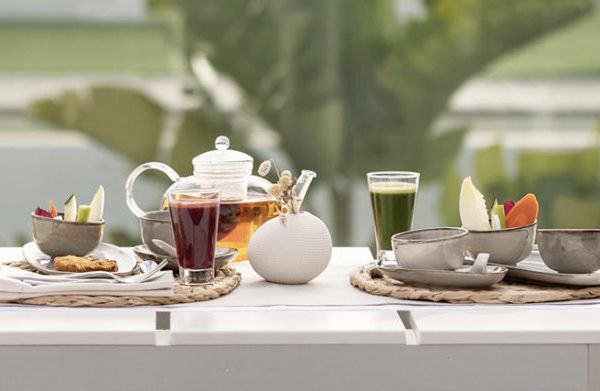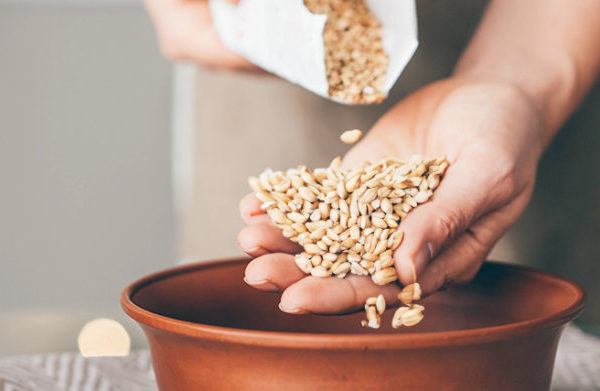
SHA Magazine Healthy Nutrition
Diary of a Nutritionist at SHA
What does a nutritionist eat? Why choose some foods over others? María Romeralo, from SHA Wellness Clinic, tells us here in her diary what a nutritionist eats and why.
Every balanced diet (a SHA diet) must include vitamins and minerals (seasonal fruits and vegetables), vegetable proteins (lentils, chickpeas, beans, azukis, tempeh), complex carbohydrates (quinoa, buckwheat, brown rice, millet, barley, oats) and quality fats (first cold pressing olive oil, seeds and nuts). And this is what Maria Romeralo writes in her diary:
DAY 1:
09:00 (breakfast). Breakfast should be healthy and contain the necessary nutrients for a good energy intake. One of the most frequent symptoms of a bad breakfast is hypoglycaemia and that is why it is so important to avoid simple sugars (refined sugar, artificial sweeteners, honey) at the first meal of the day.
Cream of rice with gum, ideal for getting strength and alkalizing the body. Gum (a mixture of sesame seeds and sea salt) is rich in calcium, strengthens the digestive system and boosts our immune system. I accompany it with kukicha tea, a tea without theine, alkalizing and rich in calcium that strengthens my digestive system.
13:00 (lunch). 1st miso soup, vegetables and tofu; 2nd quinoa with vegetables. It regulates my glucose levels, gives me energy and promotes good digestion. In addition, miso is a natural source of probiotics. Miso soup will provide us with a great deal of protein, vitamins, minerals and enzymes. It is also a wonderful way to cleanse the body. Miso is a source of probiotics that helps strengthen our immune system, which is so essential these days.
16:00 (snack). Mu tea (without theine and a source of energy, perfect for strengthening the immune system and balancing hormones) and humus with carrot sticks.
19:30 (dinner). Vegetable stir-fry in the wok. It is essential to prepare ourselves for the best rest and eating lightly helps. If we eat a lot of meals, it will be more difficult for us to sleep because our organism will be busy with digestion. It is not only about sleeping well, but it is also about promoting a complete regeneration of the organism during the rest. That’s why it’s important to know how to choose the food and how to dose the portions without being hungry.
DAY 2:
09:00 hours (breakfast). Millet cream with red fruits. Millet gives me energy and strengthens my digestive system, while red fruits provide me with vitamins and are antioxidant. I accompany it with mu tea, a source of energy.
13:00 (lunch). Lentils with brown rice and vegetables. It gives me energy, regulates glucose and contains vitamins, minerals and proteins. Daily consumption of green leaves helps reduce cholesterol.
16:30 (snack). Apple compote with sunflower seeds. It regulates my glucose levels and provides vitamins and minerals.
19:30 (dinner). Grilled carrot and tempeh cream with caramelised onion (with molasses). Carrot cream relaxes me and tempeh (vegetable protein) is a natural probiotic. Molasses is the most balanced form of sweetening.
DAY 3:
09:00 (breakfast). Oat porridge with cinnamon and nuts. Accompanied by cereal coffee with rice milk. It gives me energy and regulates the glucose in the digestive system. Oat porridge gives me energy and mental clarity by regulating blood glucose levels.
13:00 (lunch). Grilled vegetables and white fish with sauerkraut. It regulates my glucose, it’s détox and facilitates digestion.
16:30 (snack). Chia seeds with rice milk and blueberries. It regulates my intestinal transit and is satiating and antioxidant.
19:30 (dinner). Vegetable ramen. It helps me to digest well and provides a deep rest. The mushrooms included in this soup have anti-inflammatory and antioxidant properties and have extraordinary benefits for the digestive, circulatory and metabolic systems.
And if I have done sport today…
After the session I will take an extra protein in the form of lentil and avocado hummus on buckwheat or quinoa crackers.
And if it’s a holiday…
Mexican food: vegetable burritos – they are fun, healthy, creative and colourful!
Japanese food: vegetarian and fish brown rice sushi.
Italian food: cauliflower, vegetable and vegan parmesan pizza.





